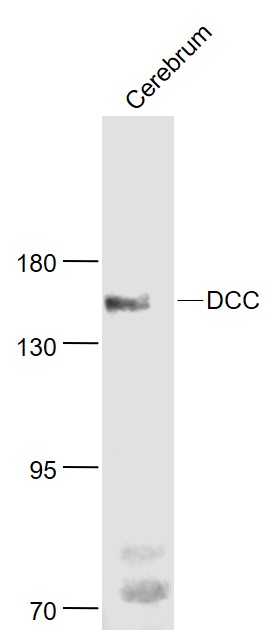
Rabbit Anti-DCC antibody
Deleted in Colorectal Cancer; Igdcc1; Immunoglobulin domain cell adhesion molecule; Colorectal cancer related chromosome sequence 18; Colorectal cancer suppressor; CRC 18; CRC18; CRCR 1; CRCR; Deleted in colorectal cancer protein; Deleted in colorectal ca
View History [Clear]
Details
Product Name DCC Chinese Name 结肠直肠癌缺失基因抗体 Alias Deleted in Colorectal Cancer; Igdcc1; Immunoglobulin domain cell adhesion molecule; Colorectal cancer related chromosome sequence 18; Colorectal cancer suppressor; CRC 18; CRC18; CRCR 1; CRCR; Deleted in colorectal cancer protein; Deleted in colorectal carcinoma; Netrin receptor DCC; Tumor suppressor protein DCC; DCC_RAT; DCC_HUMAN. literatures Research Area Tumour Cell biology Neurobiology Signal transduction Apoptosis transcriptional regulatory factor The cell membrane受体 Immunogen Species Rabbit Clonality Polyclonal React Species Mouse, (predicted: Human, Rat, Dog, Pig, Cow, Horse, Sheep, ) Applications WB=1:500-2000
not yet tested in other applications.
optimal dilutions/concentrations should be determined by the end user.Theoretical molecular weight 158kDa Cellular localization The cell membrane Form Liquid Concentration 1mg/ml immunogen KLH conjugated synthetic peptide derived from human DCC: 821-920/1461 Lsotype IgG Purification affinity purified by Protein A Buffer Solution 0.01M TBS(pH7.4) with 1% BSA, 0.03% Proclin300 and 50% Glycerol. Storage Shipped at 4℃. Store at -20 °C for one year. Avoid repeated freeze/thaw cycles. Attention This product as supplied is intended for research use only, not for use in human, therapeutic or diagnostic applications. PubMed PubMed Product Detail Deleted in colorectal cancer (DCC, chromosome 18q21) was originally identified as a putative tumor suppressor gene that is lost in more than 70% of colorectal cancers. The gene has also been deleted in several other types of cancer. The DCC protein is a type I transmembrane glycoprotein that belongs to the immunoglobulin (Ig) superfamily. The extracellular domain is composed of four Ig like domains and six fibronectin type III repeats. Native DCC is found in three isoforms. Two forms, a long and a short isoform, are produced from the same gene but have different initiation sites. The third isoform, produced by alternative splicing, is expressed only in embryonic tissue. Mouse DCC extracellular domain shares 97% and 99% homology with human and rat DCC extracellular domains, respectively. In adults, DCC is highly expressed in the brain but is also expressed at very low levels in multiple normal tissues. In the embyro, high levels of expression are detected in the brain and neural tube. DCC functions as a receptor or a component of a receptor for netrins and mediates the effects of netrins on commissural axons. Netrins are chemoattractants responsible for the guidance of commissural axons at the midline and of motor axons to the their target muscles. DCC induces apoptosis in the absence of ligand binding, blocks apoptosis when engaged by netrin 1, and also acts as a caspase substrate.
Function:
Receptor for netrin required for axon guidance. Mediates axon attraction of neuronal growth cones in the developing nervous system upon ligand binding. Its association with UNC5 proteins may trigger signaling for axon repulsion. It also acts as a dependence receptor required for apoptosis induction when not associated with netrin ligand. Implicated as a tumor suppressor gene.
Subunit:
Interacts with the cytoplasmic part of UNC5A, UNC5B, UNC5C and probably UNC5D. Interacts with DSCAM. Interacts with PTK2/FAK1. Interacts with MYO10. Interacts with MAPK1. Interacts with NTN1. Interacts with CBLN4; this interaction can be competed by NTN1.
Subcellular Location:
Membrane; Single-pass type I membrane protein.
Tissue Specificity:
Found in axons of the central and peripheral nervous system and in differentiated cell types of the intestine. Not expressed in colorectal tumor cells that lost their capacity to differentiate into mucus producing cells.
Post-translational modifications:
Ubiquitinated; mediated by SIAH1 or SIAH2 and leading to its subsequent proteasomal degradation.
DISEASE:
Defects in DCC are the cause of congenital mirror movements (MIMOC) [MIM:157600]. Mirror movements are contralateral involuntary movements that mirror voluntary ones. While mirror movements are occasionally found in young children, persistence beyond the age of 10 is abnormal. Mirror movements occur more commonly in the upper extremities.
Similarity:
Belongs to the immunoglobulin superfamily. DCC family.
Contains 6 fibronectin type-III domains.
Contains 4 Ig-like C2-type (immunoglobulin-like) domains.
SWISS:
P43146
Gene ID:
1630
Database links:Entrez Gene: 1630 Human
Entrez Gene: 13176 Mouse
Omim: 120470 Human
SwissProt: P43146 Human
SwissProt: P70211 Mouse
Unigene: 162025 Human
Unigene: 167882 Mouse
Unigene: 10666 Rat
DCC是一种抑癌基因,多用于消化系统Tumour方面的研究。Product Picture
References (0)
No References
Bought notes(bought amounts latest0)
No one bought this product
User Comment(Total0User Comment Num)
- No comment



 +86 571 56623320
+86 571 56623320
 +86 18668110335
+86 18668110335

